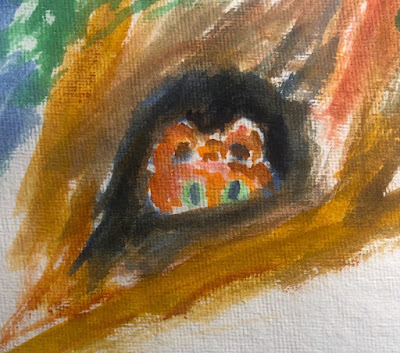 |
| Dimp the Emp, looking out from his Emp tunnel in his tree |
In fact, it may be difficult to distinguish between plant and animal with Emps, because they are so closely intertwined with trees.
But, by trying to feel the pulse of trees, and thus being rewarded for my patience and open senses in walks in Hafer Park, Emps shouldn't surprise us.
We know that trees talk to each other--scientific fact. We know that their pulse is much slower than humans. Yes it quickens in the spring and summer and then slows late in the year--much like hibernating bears and other creatures.
 |
| An Emp tunnel in Hafer Park |
Emps' close relationship with the inside of trees affects more than just their pulse. Notice the green color of their eye balls. Those eyes are very large because they primarily live in the dark, and come out only at night. But they're green. Yes green.
Why? Because of their long lives--nobody knows exactly how old they are, and their food--acorns and diseased bark--their eyeballs are green. Why? The chlorophyll that comes from the trees breathing.
Notice that their ears and tail are stubby, unlike those rodent squirrels they are mistaken for at night in brief sightings. When you're small and need to navigate cramped spaces inside trees, you don't need long ears or tails to become obstacles.
Their teeth are all molars, perfect for cracking open acorns on the ground, or decaying wood inside the tree trunk (ever wonder why you see so many hollow logs on the ground?), or from aging bark on the outside or the ground.
And speaking of bark, guess what kind of noise they make? They're hard to hear, but yes, they sound like faint barks, like those you'd hear from an old dog with tonsillitis.
Do they talk to each other? I think so--probably the way trees talk to each other through the roots in the ground. Emps are so in tune (key word) with their trees that they probably use that same network to communicate.
They also have a few tunnels you can find that may be used for gathering at their religious rites, especially on Arbor Day and Earth Day. Those ceremonies are very sacred and private. I hope to learn more.
That's enough science for today. Since I've discovered the Emps, I get to name the species in the tradition of discovery, after where I found them and their important life roles. They are Empus Arboli Haferae.
Chapter three will explore their behavior and importance to trees, and to us!
No comments:
Post a Comment
Note: Only a member of this blog may post a comment.